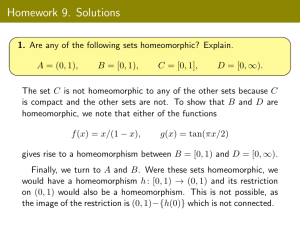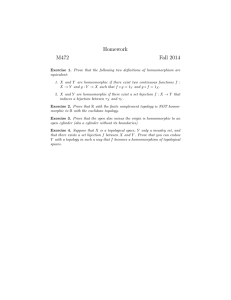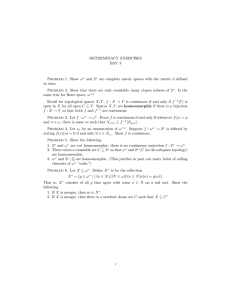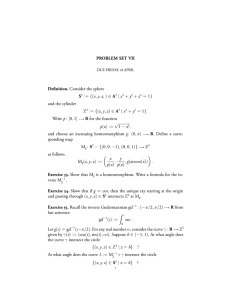Tutorial 5 solutions - School of Mathematics and Statistics, University
advertisement
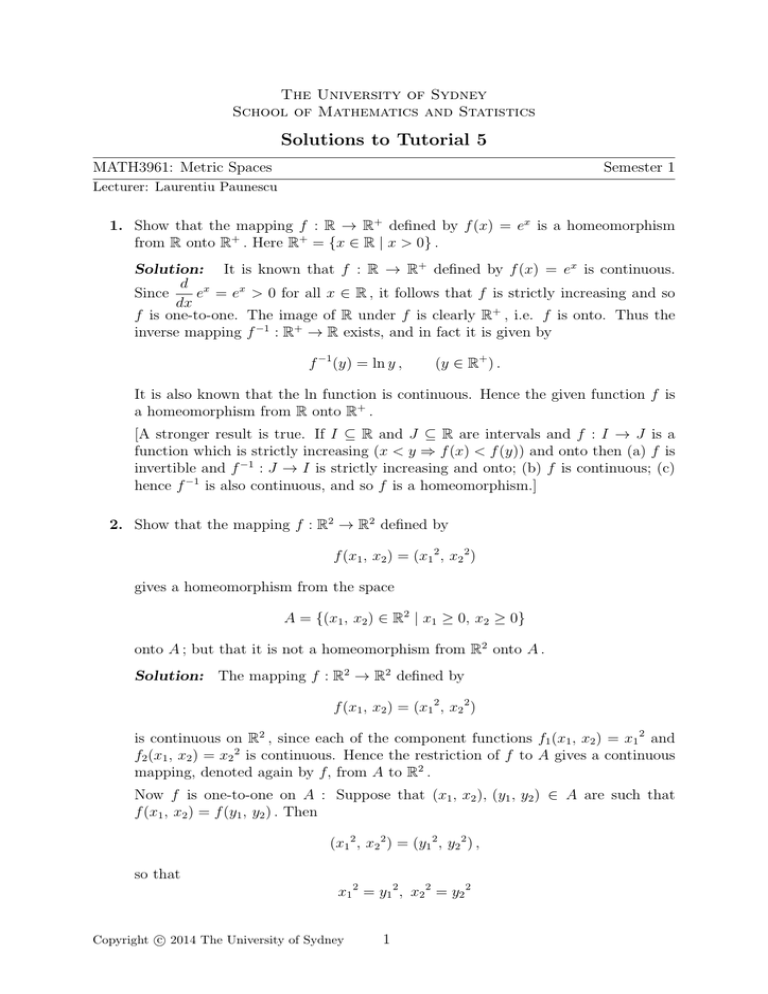
The University of Sydney
School of Mathematics and Statistics
Solutions to Tutorial 5
MATH3961: Metric Spaces
Semester 1
Lecturer: Laurentiu Paunescu
1. Show that the mapping f : R → R+ defined by f (x) = ex is a homeomorphism
from R onto R+ . Here R+ = {x ∈ R | x > 0} .
Solution: It is known that f : R → R+ defined by f (x) = ex is continuous.
d x
e = ex > 0 for all x ∈ R , it follows that f is strictly increasing and so
Since
dx
f is one-to-one. The image of R under f is clearly R+ , i.e. f is onto. Thus the
inverse mapping f −1 : R+ → R exists, and in fact it is given by
f −1 (y) = ln y ,
(y ∈ R+ ) .
It is also known that the ln function is continuous. Hence the given function f is
a homeomorphism from R onto R+ .
[A stronger result is true. If I ⊆ R and J ⊆ R are intervals and f : I → J is a
function which is strictly increasing (x < y ⇒ f (x) < f (y)) and onto then (a) f is
invertible and f −1 : J → I is strictly increasing and onto; (b) f is continuous; (c)
hence f −1 is also continuous, and so f is a homeomorphism.]
2. Show that the mapping f : R2 → R2 defined by
f (x1 , x2 ) = (x1 2 , x2 2 )
gives a homeomorphism from the space
A = {(x1 , x2 ) ∈ R2 | x1 ≥ 0, x2 ≥ 0}
onto A ; but that it is not a homeomorphism from R2 onto A .
Solution: The mapping f : R2 → R2 defined by
f (x1 , x2 ) = (x1 2 , x2 2 )
is continuous on R2 , since each of the component functions f1 (x1 , x2 ) = x1 2 and
f2 (x1 , x2 ) = x2 2 is continuous. Hence the restriction of f to A gives a continuous
mapping, denoted again by f, from A to R2 .
Now f is one-to-one on A : Suppose that (x1 , x2 ), (y1 , y2 ) ∈ A are such that
f (x1 , x2 ) = f (y1 , y2 ) . Then
(x1 2 , x2 2 ) = (y1 2 , y2 2 ) ,
so that
x1 2 = y1 2 , x2 2 = y2 2
c 2014 The University of Sydney
Copyright 1
which implies that
x1 = y1 , x2 = y2
or
(x1 , x2 ) = (y1 , y2 ) .
The image of A under f is A : For if (a1 , a2 ) ∈ A , then a1 ≥ 0, a2 ≥ 0 so that
√
√
a1 ≥ 0, a2 ≥ 0 and
√
√
f ( a1 , a2 ) = (a1 , a2 ) .
Thus f : A → A is one-to-one and onto and so the inverse f −1 of f exists. In fact,
the inverse mapping f −1 : A → A is given by
√
√
f −1 (x1 , x2 ) = ( x1 , x2 ),
(x1 , x2 ) ∈ A .
Since the component functions of f −1 are both continuous, it follows that f −1 is a
continuous mapping.
Hence the given f gives a homeomorphism from A onto A .
Finally, since f is not one-to-one on R2 , for example,
f (−1, 0) = f (1, 0) = (1, 0) ,
we conclude that f is not a homeomorphism from R2 to A .
3. Let
A = (x1 , x2 , x3 ) ∈ R3 | x1 2 + x2 2 + x3 2 = 1, (x1 , x2 , x3 ) 6= (0, 0, 1) .
Show that A is homeomorphic to R2 .
Solution: Let S 2 be the unit sphere
S 2 = (x1 , x2 , x3 ) ∈ R3 | x1 2 + x2 2 + x3 2 = 1 ,
and let N = (0, 0, 1) . Then A = S 2 \ {(0, 0, 1)} .
x3
N = (0, 0, 1)
R2 = x1 x2 -plane
P
O
x2
P′
x1
The radial projection, with centre N , of A onto the x1 x2 -plane, corresponds to
2
f : A → R2 which is given by
x
x2 1
,
,
f (x1 , x2 , x3 ) =
1 − x3 1 − x3
(x3 6= 1) .
Since the component functions are continuous, f is continuous. Since each ray, not
in the tangent plane x3 = 1, meets each of A and x1 x2 -plane in exactly one point,
and these rays contain all the points of A and the x1 x2 -plane, we see that f is a
one-to-one mapping from A onto R2 . Thus the inverse mapping f −1 : R2 → A of
f exists and it is given by
(1)
f −1 (y1 , y2 ) =
2y1
2y2
y1 2 + y2 2 − 1 ,
,
.
y1 2 + y2 2 + 1 y1 2 + y2 2 + 1 y1 2 + y2 2 + 1
In fact, suppose that f −1 (y1 , y2 ) = (x1 , x2 , x3 ) ∈ A . Then x1 2 + x2 2 + x3 2 = 1 and
we have
(2)
y1 =
x2
x1
, y2 =
.
1 − x3
1 − x3
N = (0, 0, 1)
1 − x3
Q (x1 , x2 , x3 )
′
O
Q (y1 , y2 , 0)
1
As shown in the figure, we see that
1 − x3
N Q′
=
.
1
NQ
Thus
x1 2 + x2 2 + (x3 − 1)2
y1 2 + y2 2 + 1
x1 2 + x2 2 + x3 2 − 2x3 + 1
=
y1 2 + y2 2 + 1
2(1 − x3 )
.
= 2
y1 + y2 2 + 1
(1 − x3 )2 =
3
Therefore
1 − x3 =
y1
2
2
,
+ y2 2 + 1
and so by (2), we obtain
x1 =
y1
2
Also,
x3 = 1 −
2y1
2y2
, x2 = 2
.
2
+ y2 + 1
y1 + y2 2 + 1
2
y1 2 + y2 2 − 1
=
.
y1 2 + y2 2 + 1
y1 2 + y2 2 + 1
Hence f −1 (y1 , y2 ) is given by (1). Finally, since all the components of f −1 are
continuous, f −1 is continuous. Consequently A is homeomorphic to R2 .
4. Let (X, d) be any metric space. Let d1 and d2 be the metrics on X defined by
d1 (x, y) = min 1, d(x, y) ,
and
d2 (x, y) =
d(x, y)
.
1 + d(x, y)
Prove that d, d1 and d2 are all equivalent on X.
Solution: Clearly
d1 (x, y) ≤ d(x, y)
for all x, y ∈ X, so that the identity mapping of (X, d) onto (X, d1 ) is continuous.
Now, we will prove that the identity mapping of (X, d1 ) onto (X, d) is continuous.
For any ε > 0, we choose δ = min{1, ε}. Then we see that
d1 (x, y) < δ
=⇒
d(x, y) < ε.
Thus the identity mapping of (X, d1 ) onto (X, d) is continuous and so the identity
mapping of (X, d1 ) onto (X, d) is a homeomorphism. Hence d and d1 are equivalent. Next, since d2 (x, y) ≤ d(x, y), for all x, y ∈ R, we see that the identity
mapping of (X, d) onto (X, d2 ) is continuous. Now, we will prove that the identity
mapping of (X, d2 ) onto (X, d) is continuous. To show this, observe that if ε > 0
and
d(x, y)
ε
d2 (x, y) =
<
,
1 + d(x, y)
1+ε
then d(x, y) < ε. Thus given ε > 0, if we set δ = ε/(1 + ε), then we have
d2 (x, y) < δ
=⇒
d(x, y) < ε.
Thus the identity mapping of (X, d2 ) onto (X, d) is continuous and so the identity mapping of (X, d2 ) onto (X, d) is a homeomorphism. Hence d and d2 are
equivalent. Consequently, d, d1 and d2 are all equivalent on X.
4
5. Let X = [1, ∞) with d the Euclidean metric and let f : X → X be given by
25
f (x) = (x + 1/x).
26
Show that
25
d(x, y),
d f (x), f (y) ≤
26
[and so f is a contraction mapping] and by solving the equation algebraically, show
that 5 is the unique fixed point of f .
Solution: For any x, y ∈ X, we have
25
25
d f (x), f (y) = |f (x) − f (y)| = (x + 1/x) − (y + 1/y)
26
26
1
25
25 d(x, y),
1 − |x − y| <
=
26
xy
26
since x ≥ 1 and y ≥ 1. Hence f is a contraction mapping.
If f (x) = x, then
25
(x + 1/x) = x
26
which implies that x2 = 25 and so x = 5 is the unique fixed point of f in X.
6. Let X = [0, 1] with d the Euclidean metric and let f : X → X be given by
1
f (x) = (x3 + x2 + 1).
7
Show that
5
d f (x), f (y) ≤ d(x, y).
7
(2)
(3)
Calculate f (0), f (0), f (0), . . . , and hence find, to three decimal places, the
fixed point of f .
Solution: For any x, y ∈ X, we see that
1 3
1 3
2
2
d f (x), f (y) = |f (x) − f (y)| = (x + x + 1) − (y + y + 1)
7
7
1 3
1
|(x − y 3 ) + (x2 − y 2 )| = |(x − y)(x2 + xy + y 2 + x + y)|
7
7
5
5
≤ |x − y| = d(x, y),
7
7
=
since 0 ≤ x ≤ 1 and 0 ≤ y ≤ 1.
Using the calculator, one can compute that
f (0) = 0.142857, f (2) (0) = f (0.142857) = 0.1457767,
f (3) (0) = f (0.1457767) = 0.145897, · · · .
Hence the fixed point of f is x = 0.146, to three decimal places.
5
7. Let f : [a, b] → [a, b] be differentiable over [a, b]. Show that f is a contraction
mapping if and only if there exists a number K < 1 such that for all x ∈ (a, b),
|f ′ (x)| ≤ K.
Solution: Suppose first that f is a contraction mapping, i.e. that there exists
K < 1 such that
|f (x) − f (y)| ≤ K|x − y|,
for all x, y ∈ [a, b]. Then, in particular, for and x and x + δx in [a, b], we have
|f (x + δx) − f (x)| ≤ K|(x + δx) − x| = K|δx|.
Hence for δx 6= 0,
f (x + δx) − f (x) ≤ K,
δx
and the limit of the left-hand expression as δx → 0 is also less than or equal to
K. But that limit is precisely |f ′ (x)|. Hence there exists K < 1 such that for all
x ∈ (a, b),
|f ′ (x)| ≤ K.
Conversely, asssume that for all x ∈ (a, b),
|f ′ (x)| ≤ K < 1.
Now for any x 6= y in [a, b], there is c between x and y such that
f (x) − f (y)
= f ′ (c).
x−y
But |f ′ (c)| ≤ K so that
Hence, for all x, y ∈ [a, b],
f (x) − f (y) ′
x − y = |f (c)| ≤ K.
|f (x) − f (y)| ≤ K|x − y|,
and so f is a contraction mapping.
8. Let X = C[0, 1] be the metric space with d given by
d(f, g) = sup |f (x) − g(x)|.
x∈[0, 1]
Define F : X → X by
{F (f )}(x) =
Z
x
f (t) dt
0
Show that
6
(f ∈ X).
1. {F (f )}(x) − {F (g)}(x) ≤ x d(f, g),
2. {F (2) (f )}(x) − {F (2) (g)}(x) ≤
x2
d(f, g),
2
for all f, g ∈ X, and deduce that F (2) is a contraction mapping. Show, however,
that F is not a contraction mapping.
Solution:
1. We have
x
{F (f )}(x) − {F (g)}(x) =
Z
≤
Z
(g)}(x) =
Z
≤
Z
f (t) − g(t) dt
0
x
0
d(f, g) dt ≤ x d(f, g).
2. We have
{F
(2)
(f )}(x) − {F
(2)
x
0
{F (f )}(t) − {F (g)}(t) dt
x
t d(f, g) dt =
0
x2
d(f, g).
2
It follows that
d F (f ), F (g) = sup |{F (f )}(x) − {F (g)}(x)|
x∈[0, 1]
≤ sup x d(f, g) ≤ d(f, g),
x∈[0, 1]
and
d F (2) (f ), F (2) (g) = sup |{F (2) (f )}(x) − {F (2) (g)}(x)|
x∈[0, 1]
≤ sup
x∈[0, 1]
x2
1
d(f, g) ≤ d(f, g).
2
2
Hence F (2) is a contraction mapping.
But F is not, since by taking f = 1 and g = 0, we have d F (f ), F (g)
supx∈[0,1] x = 1 = d(f, g).
=
9. Let A = S 1 be the unit circle in R2 and B = [0, 2π) ⊆ R. Prove that the mapping
f : B → A defined by
f (x) = (cos x, sin x)
7
is a continuous bijection, but that f −1 is not continuous.
Solution: Since each of the components of f is continuous, it follows that f is
continuous. The mapping f is clearly a bijection and so f −1 : A → B exists.
To show that f −1 is not continuous, we need to produce an open set U in B for
which the inverse image (f −1 )−1 (U ) = f (U ) is not open in A. Take U = [0, π/2).
Then clearly U is open in B. But
f (U ) = {(cos x, sin x) | 0 ≤ x < π/2}
is not open in A. In fact, if we take the point y = (1, 0) ∈ f (U ), then we see that
for any open ball BA (y; ε) in A,
BA (y; ε) ∩ (A \ f (U )) 6= ∅,
and so f (U ) is not open in A. Hence f −1 is not continuous. [Recall that BA (y; ε) =
B(y; ε) ∩ A.]
10. Let X = Rn and let d1 and d2 be the metrics on X given by
d1 (x, y) =
n
nX
k=1
|xk − yk |p
o1/p
,
where p ≥ 1, and
d2 (x, y) = max(|x1 − y1 |, |x2 − y2 |, . . . , |xn − yn |) .
Prove that d1 and d2 are equivalent over X.
Solution: Clearly, for k = 1, 2, . . . , n
d1 (x, y) ≥ |xk − yk |
so that
d1 (x, y) ≥ d2 (x, y) ,
for all x, y ∈ X. Next, we see that
d1 (x, y) ≤
n
nX
=
n
nX
k=1
(max |xk − yk |)
K=1
k
d2 (x, y)
p o1/p
p 1/p
= n d2 (x, y)
,
and so
for all x, y ∈ X.
d1 (x, y) ≤ n1/p d2 (x, y) ,
Hence d1 and d2 are equivalent over X.
8
p
o1/p
11. Let
A = (x1 , x2 , x3 ) ∈ R3 | x1 2 + x2 2 + x3 2 = 1, x3 < 0 .
Show that A is homeomorphic to R2 .
Solution: Let P be the plane x3 = −1. Then it is easy to see that A touches
the plane P at (0, 0, −1) .
x3
x2
x1
P
(0, 0, −1)
P′
P : x3 = −1
Now we project A from O onto the plane P . Similar to Question 4, one finds that
the homeomorphism f : A → P is given by
x
x2
1
f (x1 , x2 , x3 ) = − , − , −1 , (x1 , x2 , x3 ) ∈ A ;
x3
x3
and its inverse f −1 : P → A is given by
y2
−1
y1
−1
, p
, p
.
f (y1 , y2 , −1) = p
y1 2 + y2 2 + 1
y1 2 + y2 2 + 1
y1 2 + y2 2 + 1
(Please check the answer!) Hence A is homeomorphic to P . But P is clearly
homeomorphic to R2 . Consequently A is homeomorphic to R2 .
12. Let
A = (x1 , x2 ) ∈ R2 | x1 2 + x2 2 < 1 .
Show that A is homeomorphic to R2 .
Solution: By Question 5, we know that the southern hemisphere A1 (without
the equator) is homeomorphic to R2 . Now, the mapping f : A1 → A given by
f (x1 , x2 , x3 ) = (x1 , x2 ) ,
(x1 , x2 , x3 ) ∈ A1 ,
is clearly continuous, one-to-one and onto, and its inverse f −1 : A → A1 is given
by
p
f −1 (y1 , y2 ) = y1 , y2 , − 1 − y1 2 − y2 2 .
Again, we see that f −1 is continuous. Hence A is homeomorphic to A1 . Since A1
is homeomorphic to R2 , it follows that A is homeomorphic to R2 .
9
